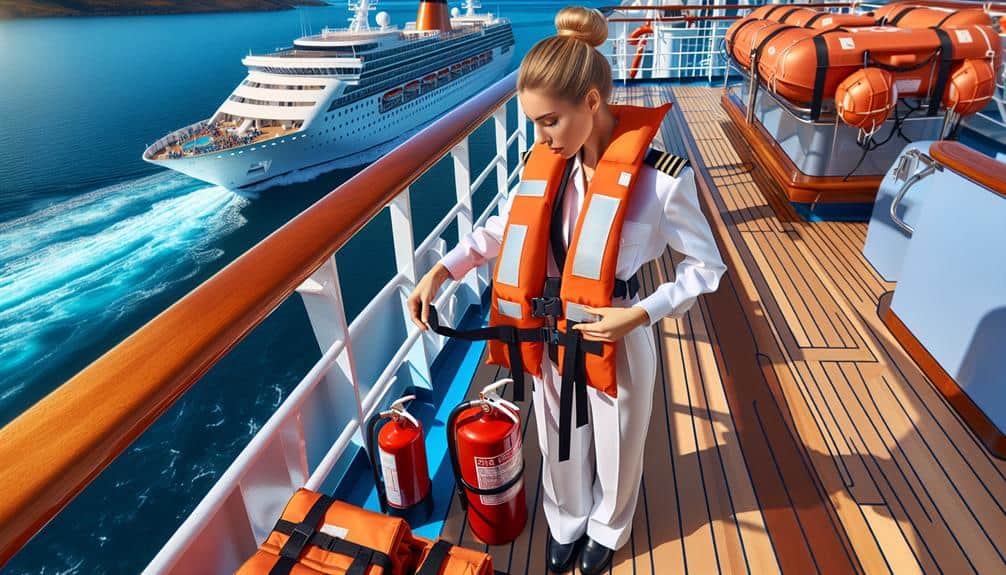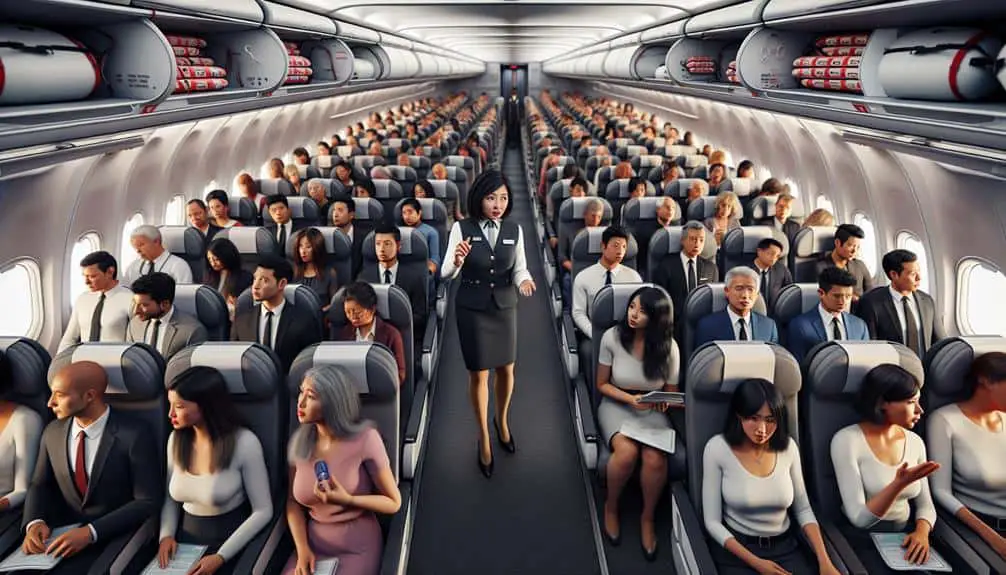Conducting safety equipment checks on cruise ships is essential for your protection. Regular inspection of lifeboats, rafts, fire extinguishers, and alarms guarantees they function properly in emergencies. Emergency drills help familiarize everyone onboard with these safety tools. Adhering to strict regulatory standards set by maritime organizations is critical. Neglecting safety equipment checks can result in legal consequences and jeopardize lives. To enhance safety further, crew training, emergency drills, and meticulous record-keeping are recommended. Learn more about the types of safety equipment, regulatory standards, consequences of neglect, and best practices to ensure safety compliance onboard.
Key Points
- Ensures safety of passengers and crew during emergencies.
- Prevents equipment failures through regular maintenance checks.
- Compliance with stringent regulatory standards is imperative.
- Neglecting checks can result in legal implications and reputational damage.
- Conducting crew training and emergency drills enhances safety preparedness.
Importance of Safety Equipment Checks
Regular and meticulous safety equipment checks are essential for ensuring the effectiveness and reliability of emergency response systems on cruise ships. The importance of conducting these maintenance checks can't be overstated as they directly impact the safety of passengers and crew members in potentially life-threatening situations.
By regularly inspecting and testing safety equipment such as lifeboats, life rafts, fire extinguishers, and emergency alarms, cruise ship operators can identify any issues promptly and address them before they escalate into serious problems during emergencies.
Maintenance checks play a key role in ensuring that safety equipment functions as intended when needed. These checks involve detailed inspections, testing mechanisms, and verifying expiration dates of essential items. Proper maintenance also includes replenishing supplies, such as fresh batteries in emergency lights and ensuring that safety gear is readily accessible and in good working condition.
Neglecting these checks can lead to equipment failures during crises, jeopardizing the safety of everyone on board. As a result, a meticulous approach to safety equipment maintenance is critical for a well-prepared and secure cruise ship environment.
Types of Safety Equipment on Ships
To guarantee the safety and readiness of a cruise ship in emergencies, understanding the various types of safety equipment on board is essential. Emergency drills play an important role in familiarizing passengers and crew with the location and proper use of life-saving devices.
Lifeboats are indispensable safety equipment found on all cruise ships, designed to evacuate passengers and crew in the event of an emergency. Additionally, life rafts are available as supplementary emergency flotation devices.
Personal flotation devices, commonly known as life jackets, are provided for each individual on board and must be worn during emergency situations. Buoyant apparatus such as lifebuoys are strategically placed along the ship's rails for immediate deployment if someone falls overboard.
Fire extinguishers, fire hoses, and firefighting suits are crucial to combat onboard fires. Understanding the functionality and location of these safety equipment items is essential for ensuring a prompt and effective response during emergencies at sea.
Regulatory Standards for Cruise Ship Safety
Ensuring adherence to stringent safety regulations is paramount for maintaining the well-being of passengers and crew aboard cruise ships. Regulatory requirements for cruise ship safety are established by international maritime organizations such as the International Maritime Organization (IMO) and the Cruise Lines International Association (CLIA). These regulations encompass a wide range of safety aspects, including emergency preparedness, fire safety, life-saving appliances, and pollution prevention measures.
Industry guidelines play a vital role in supplementing regulatory requirements to enhance safety standards further. These guidelines are often developed by industry experts and organizations to address specific safety concerns that may not be explicitly covered by regulations. Cruise ship operators are expected to not only meet but also exceed these industry guidelines to ensure the highest level of safety for everyone on board.
Compliance with regulatory requirements and industry guidelines is regularly monitored through inspections and audits conducted by classification societies and flag state authorities. Failure to meet these standards can result in severe consequences, including penalties, operational restrictions, and damage to the cruise ship's reputation. A thorough understanding and implementation of regulatory standards are essential for ensuring the safety of all individuals on a cruise ship.
Consequences of Inadequate Equipment Checks
Adhering to rigorous safety equipment checks on cruise ships is essential to mitigate the potential consequences of inadequate inspections. Failing to conduct thorough equipment checks can lead to severe legal implications for the cruise line. In the event of an incident where safety equipment is found to be faulty due to inadequate inspections, the cruise line may face lawsuits, fines, and reputational damage. Legal battles resulting from negligence in equipment checks can be lengthy and costly, posing significant financial risks to the company.
Moreover, the consequences of inadequate equipment checks extend beyond legal implications. In situations where safety equipment malfunctions during an emergency, lives are put in jeopardy. Passengers and crew rely on the functionality of safety equipment to guarantee their well-being in critical situations. Overlooking the importance of thorough equipment checks not only poses legal and financial risks but also jeopardizes the safety and security of everyone on board a cruise ship.
Best Practices for Ensuring Safety Compliance
Implementing stringent safety protocols is paramount to guaranteeing compliance with safety regulations on cruise ships. To assure safety compliance, follow these best practices:
- Regular Crew Training: Conduct frequent training sessions for all crew members to familiarize them with emergency procedures, proper equipment usage, and evacuation protocols.
- Simulated Emergency Drills: Organize regular emergency drills to test the crew's response time, coordination, and efficiency in handling various safety scenarios.
- Documentation and Record-Keeping: Maintain detailed records of safety equipment checks, crew training sessions, and emergency drill outcomes to track compliance and identify areas for improvement.
- Continuous Improvement: Regularly review safety protocols, seek feedback from crew members, and adjust procedures as needed to enhance overall safety preparedness on the cruise ship.
Frequently Asked Questions
How Often Are Safety Equipment Checks Typically Conducted on Cruise Ships?
Safety equipment checks on cruise ships are typically conducted on a regular basis to verify compliance with maintenance schedules and safety regulations. Frequency varies but is often performed at set intervals to uphold readiness.
Are There Any Specific Emergency Scenarios Where Certain Safety Equipment Would Be More Crucial Than Others?
In various emergency scenarios on cruise ships, specific safety equipment like lifeboats and fire extinguishers become essential for passenger safety. Conducting regular drills guarantees readiness and familiarity with these tools.
What Training Do Crew Members Undergo to Ensure They Can Effectively Use the Safety Equipment in Case of an Emergency?
In crew training, emergency scenarios are prioritized to guarantee effective use of safety equipment. Familiarity with protocols and regular drills sharpens response skills, crucial for swift and competent actions during critical situations at sea.
Are There Any New Advancements in Safety Equipment Technology That Cruise Ships Are Implementing to Improve Safety Measures?
New technologies have revolutionized cruise ship safety. Advanced emergency response systems, like automated fire suppression and man-overboard detection, enhance onboard safety. Crew training remains vital to effectively utilizing these innovations, ensuring passenger well-being.
How Do Cruise Ships Ensure That All Safety Equipment Is Properly Maintained and in Working Condition at All Times?
To guarantee safety, cruise ships conduct regular inspections and adhere to strict maintenance protocols for all safety equipment. This meticulous approach guarantees that every piece of gear is properly maintained and in top working condition at all times.




